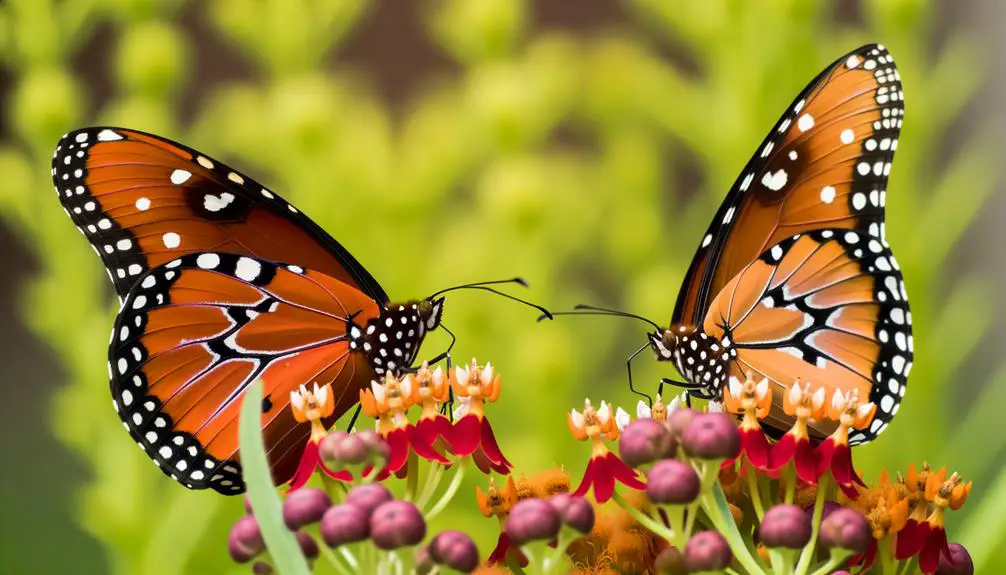How to Identify Male vs Female Queen Butterflies
Male and female Queen butterflies exhibit notable differences in physical characteristics, wing patterns, size, and behavior. Males possess a narrower, streamlined body and hindwing scent scales, while females have broader wings and a robust abdomen.
Male coloration is more vibrant with distinct vein markings, compared to the subtler hues of females. Size disparities include a larger wingspan and body mass in females.
Males are known for their territorial and active mating behavior, contrasting with the more reclusive, egg-laying focus of females. These differences play critical roles in their survival and reproductive strategies, shedding light on their ecological importance.

Male and Female Queen Butterflies
| Feature | Male Queen Butterfly | Female Queen Butterfly |
|---|---|---|
| Wing Pattern | Similar to female | Similar to male |
| Black Spot on Hindwing | Present | Absent |
| Wing Veins | Thinner | Thicker, giving a darker appearance |
| Abdomen Shape | Slimmer with claspers at tip | Rounder with ovipositor at tip |
| Size | Generally slightly smaller | Generally slightly larger |
| Behavior | Patrols territories, chases others | Searches for host plants to lay eggs |
Physical Appearance

While both male and female Queen butterflies (Danaus gilippus) share similar coloration and patterns, distinct differences in their physical appearance can be observed upon closer examination.
Males typically exhibit a narrower abdomen and possess specialized scent scales known as androconia, located on their hindwings. These androconia are absent in females, who exhibit a more robust and rounded abdomen.
Additionally, the male’s forewings are slightly narrower, contributing to a more streamlined shape compared to the broader wings of females.
These physical distinctions are essential for identifying the sexes in field studies and understanding their respective roles in mating behaviors. By recognizing these differences, researchers can better study population dynamics and ecological interactions within Queen butterfly communities.
Wing Patterns
The wing patterns of male and female Queen butterflies exhibit notable differences in coloration and vein markings.
Males typically display more vibrant orange hues, while females often show a slightly darker and more subdued coloration.
Additionally, the vein markings in males tend to be more pronounced and distinct compared to those in females.
Coloration Differences
Male and female Queen butterflies exhibit distinct coloration differences in their wing patterns, which can be observed through variations in hue, markings, and overall color intensity. Male butterflies typically display a darker and more uniform coloration, with a rich brown hue dominating the wings.
In contrast, females exhibit lighter shades and more pronounced contrast between the brown and white markings. The intensity and distribution of color can serve as an important characteristic for differentiation.
| Aspect | Male Queen Butterfly | Female Queen Butterfly |
|---|---|---|
| Dominant Hue | Rich Brown | Lighter Brown |
| Color Intensity | Darker | Lighter |
| Markings | Less Pronounced | More Pronounced |
| Overall Contrast | Low | High |
| Wing Color Uniformity | High | Moderate |
These differences provide significant insights into the sexual dimorphism of Queen butterflies.
Vein Markings
In addition to coloration differences, the vein markings on the wings of male and female Queen butterflies further illustrate their sexual dimorphism, with males exhibiting straighter and less branched veins compared to the more intricate and branched vein patterns found in females.
The straighter vein configuration in males is hypothesized to contribute to more efficient flight mechanics, aiding in mate location and territorial defense. Conversely, the complex vein patterns in females may enhance structural integrity of the wings, supporting their role in oviposition and extended flight periods during egg-laying.
This differentiation in vein morphology underscores the evolutionary adaptations tailored to their respective reproductive roles, providing an effective means of identification and understanding of their ecological interactions.
Size Differences

Exhibiting distinct size variations, female Queen butterflies are generally larger than their male counterparts, with differences measurable in both wingspan and body mass. Scientific observations indicate that these size differences are significant and consistent across various populations.
| Characteristic | Female Queen Butterfly | Male Queen Butterfly |
|---|---|---|
| Average Wingspan (cm) | 9.5 – 11.0 | 8.5 – 10.0 |
| Average Body Mass (g) | 0.65 – 0.85 | 0.50 – 0.70 |
| Wing Surface Area (cm²) | 45 – 50 | 40 – 45 |
| Thorax Width (mm) | 3.5 – 4.0 | 3.0 – 3.5 |
| Abdomen Length (mm) | 18 – 22 | 16 – 20 |
Such dimensional variations can impact their flight dynamics and energy expenditure, influencing their overall ecological roles and interactions.
Behavior Traits
Beyond their physical dimensions, Queen butterflies exhibit distinct behavioral traits that further differentiate males from females.
Male Queen butterflies are more territorial, often engaging in patrolling behavior to defend their chosen areas. They exhibit increased activity levels, frequently flying and searching for suitable perches to assert dominance.
In contrast, females display more reclusive behavior, spending considerable time feeding on nectar and laying eggs on host plants. This behavior aids in maximizing reproductive success by ensuring ample energy reserves and ideal egg placement.
Additionally, males are observed to produce and release pheromones from specialized abdominal glands, a behavior absent in females.
These divergent behavioral traits are essential for their respective roles in survival and reproduction within their ecological niches.
Mating Rituals

The mating rituals of Queen butterflies are complex and involve a series of intricate behaviors that promote successful reproduction.
These behaviors include:
- Pheromone Release: Males emit pheromones to attract females, signaling their readiness to mate.
- Courtship Flight: The male engages in a display flight around the female, showcasing his agility and strength.
- Copulatory Positioning: Upon the female’s acceptance, the male positions himself for copulation, aligning their abdomens.
These steps guarantee proper mate selection and genetic diversity.
The initial pheromone release serves as a chemical communication system, critical for species recognition.
Courtship flights allow females to evaluate potential mates based on physical performance.
Lifecycle Roles
In the lifecycle roles of Queen butterflies, significant differences can be observed between males and females, particularly in their reproductive and survival strategies.
Males primarily focus on locating mates and transferring spermatophores, while females invest in egg-laying and ensuring the propagation of the species.
These roles influence their respective behaviors and physiological adaptations throughout their life stages.
Key Lifecycle Differences
Significant differences in lifecycle roles between male and female Queen butterflies (Danaus gilippus) can be observed particularly in their reproductive behaviors and territoriality.
The male plays an active role in the establishment and maintenance of territories, which are essential for attracting mates. Conversely, the female’s primary role is centered around oviposition and ensuring the continuation of the species.
Key lifecycle differences include:
- Territoriality: Males aggressively defend territories to attract females.
- Mate Attraction: Males use pheromones to entice females within their territories.
- Egg Laying: Females allocate significant time to locating suitable host plants for oviposition.
These distinctions underscore the differing ecological and evolutionary strategies adopted by each gender in fulfilling their lifecycle roles.
Mating and Reproduction
Mating and reproduction in Queen butterflies (Danaus gilippus) involve highly specialized behaviors that guarantee successful fertilization and subsequent propagation of the species.
Males possess specialized scent scales called androconia, which release pheromones to attract females. During courtship, males engage in a series of aerial displays to demonstrate fitness.
Upon acceptance, copulation occurs, during which the male transfers a spermatophore containing sperm and nutrients essential for egg development.
Females, equipped with ovipositors, subsequently lay fertilized eggs on host plants, usually milkweeds, ensuring larval food supply.
The reproductive process is intricately timed with environmental cues to maximize offspring survival.
Understanding these behaviors is vital for conservation efforts, as disruptions in mating can greatly impact population dynamics.
Survival Strategies
Queen butterflies (Danaus gilippus) employ a range of survival strategies across their lifecycle stages, each specifically adapted to enhance survival and reproductive success. These strategies manifest differently across genders, reflecting their distinct roles in the lifecycle.
- Egg Laying and Positioning: Female butterflies strategically lay eggs on milkweed, ensuring larvae access to toxins that deter predators.
- Chemical Defenses: Males and females accumulate cardenolides from milkweed, providing chemical protection against predators.
- Behavioral Adaptations: Males exhibit territorial behaviors to secure mating opportunities, while females focus on optimizing oviposition sites.
These strategies underscore the adaptive measures of Danaus gilippus, tailored to maximize their fitness and propagation of the species.
Feeding Habits

Both male and female Queen butterflies exhibit similar feeding habits, primarily consuming nectar from a variety of flowering plants. They possess a specialized proboscis, allowing them to access nectar deep within flowers.
Key nectar sources include milkweed, lantana, and verbena, which provide essential carbohydrates for energy. Additionally, Queen butterflies sometimes engage in a behavior known as ‘puddling,’ where they absorb moisture and minerals from damp soil, which is critical for their reproductive success and overall health.
Their feeding patterns are influenced by environmental factors such as floral availability and climatic conditions. Understanding their feeding ecology is significant for conservation efforts, as it underscores the importance of maintaining diverse and abundant floral resources in their habitats.
Territoriality
In Queen butterflies (Danaus gilippus), territorial behavior exhibits notable sexual dimorphism, with males actively engaging in the defense of mating territories to enhance reproductive success.
Males are observed to patrol and defend specific areas rich in nectar resources to attract females and deter rival males.
In contrast, females typically do not exhibit territorial aggression, focusing instead on foraging and oviposition activities.
Mating Territory Behavior
Territoriality in mating behavior among Queen butterflies is a critical aspect of their reproductive strategy, influencing both male and female interactions within their habitats.
Males are particularly territorial, often engaging in aggressive displays to secure ideal mating sites.
This behavior can be summarized in three key points:
- Establishment of Territory: Males select and defend specific areas that attract females, usually rich in resources or suitable for oviposition.
- Aggressive Interactions: Males exhibit aggressive behaviors such as chasing and physical combat to ward off rivals and maintain control over their territory.
- Female Choice: Females are influenced by the quality of the male’s territory, often selecting mates based on territory characteristics, which indirectly signals the male’s fitness.
These behaviors guarantee successful mating and propagation of the species.
Nectar Resource Defense
Males of the Queen butterfly species not only defend mating territories but also exhibit territoriality over nectar resources, which are essential for their energy and reproductive success.
These males actively patrol and guard flowering plants, ensuring exclusive access to high-quality nectar. This behavior is driven by the necessity to maintain sufficient energy levels for sustained flight and successful mating displays.
Nectar resource defense involves aggressive interactions with other males, often resulting in aerial chases and physical confrontations.
This territorial behavior contrasts with female Queen butterflies, which typically do not exhibit the same level of aggression or territoriality over nectar sources.
Understanding these behavioral differences provides insight into the distinct ecological strategies employed by male and female Queen butterflies.
Predation Risks

Although both male and female Queen butterflies face various predation risks, their differing behaviors and physiological traits influence their vulnerability to predators. Males, often more visible due to their active territorial and mating behaviors, are frequently at higher risk of predation.
Females, on the other hand, exhibit more cryptic behavior while laying eggs, reducing their visibility to predators but not eliminating the risk entirely. Additionally, both sexes possess chemical defenses derived from their host plants, yet the efficacy can vary.
- Behavioral Exposure: Males’ territorial displays increase predation risk.
- Cryptic Behavior: Females’ egg-laying habits provide some camouflage.
- Chemical Defenses: Both sexes utilize plant-derived toxins, but effectiveness varies.
Understanding these distinctions aids in comprehending their survival strategies.
Ecological Impact
The ecological impact of Queen butterflies, both male and female, encompasses their roles in pollination, their interactions with host plants, and their position within the food web, contributing greatly to ecosystem dynamics.
Queen butterflies facilitate the pollination of various flowering plants, thereby aiding in plant reproduction and genetic diversity. Their larval stage depends on milkweed, highlighting their critical relationship with this host plant. In addition, Queen butterflies serve as prey for birds, spiders, and other predators, integrating them into the trophic levels of their habitats. The vibrant colors and nectar-rich blooms of certain flowers attract Queen butterflies, encouraging their presence in gardens and natural habitats. By cultivating native plants like milkweed, people can support their life cycle while also benefiting local ecosystems. Ensuring a diverse plant selection further enhances biodiversity and sustains the intricate connections within the food web.
| Aspect | Male Queen Butterfly | Female Queen Butterfly |
|---|---|---|
| Pollination | High | Moderate |
| Host Plant Use | Milkweed | Milkweed |
| Predation Risk | Moderate | High |
| Nectar Sources | Varied | Varied |
| Ecosystem Role | Pollinator, Prey | Pollinator, Prey |
Conclusion
The comparative analysis of male and female Queen butterflies reveals remarkable distinctions in physical appearance, wing patterns, and size differences.
Behavioral traits and mating rituals further differentiate the sexes, while feeding habits and territoriality underscore their ecological roles.
Predation risks present persistent perils, yet both genders contribute considerably to their ecosystems.
This synthesis showcases the dynamic diversity and delicate balance inherent in the natural world, emphasizing the essential ecological impact of these enchanting creatures.






